Margaret Livingston (1895–1984) was an American film actress and businesswoman, most notable for her work during the silent film era. She remains best known today as 'the Woman from the City' in F.W. Murnau's classic Sunrise: A Song of Two Humans (1927).
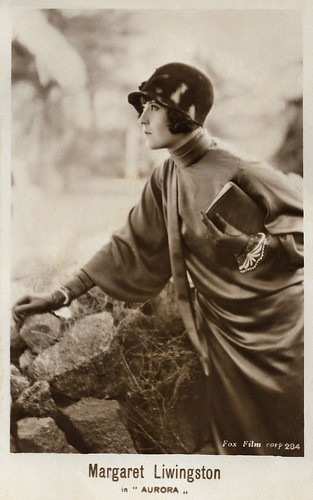
Italian postcard by G. B. Falci Editore, Milano, no. 284. Photo: Fox Film. Publicity still for Sunrise (F.W. Murnau, 1927).
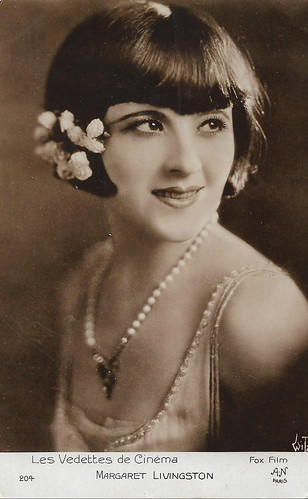
French postcard in the Les Vedettes de Cinéma series by A.N., Paris, no. 204. Photo: Albert Witzel / Fox Film.
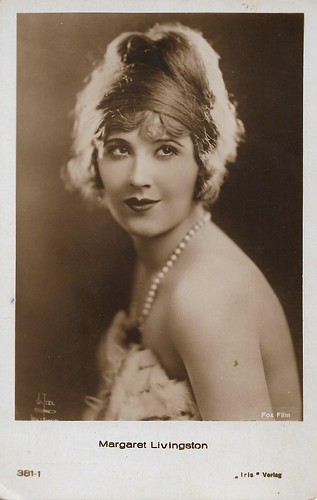
Austrian postcard by Iris Verlag, no. 381-1. Photo: Albert Witzel, Hollywood / Fox Film.
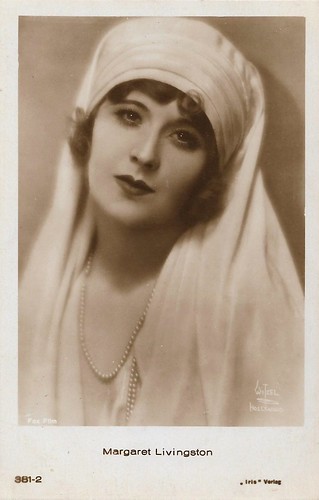
Austrian postcard by Iris Verlag, no. 381-2. Photo: Albert Witzel, Hollywood / Fox Film.
Margaret Livingston was born in Salt Lake City as the daughter of Scottish immigrant John Livingston and his wife Eda from Stockholm.
Livingston came to the cinema as a teenager. Unlike other actresses of her time, she had not previously gained any stage experience. In The Chain Invisible (Frank Powell, 1916), the actress, who initially also appeared under the name of Marguerite Livingston, first appeared on the screen.
She became a sought-after actress in the 1920s and appeared in almost 50 films until the end of the silent film era. Only rarely, the petite, just 1.60 m tall actress with the chestnut hair and the dark, slit-like eyes, had leading roles.
Often she played the female antagonist to the female lead. Several times she played seductresses of European descent, e.g. the French women in His Private Life (Frank Tuttle, 1928) with Adolphe Menjou, and Innocents of Paris (Richard Wallace, 1929) with Maurice Chevalier.
In the early 1920s, Livingston often played at Paramount, in the mid-1920s at Fox and at the end of the decade at Paramount, mixed with a wide string of other companies, such as First National, Pathé Exchange, Tiffany, FBO, Universal, and MGM.
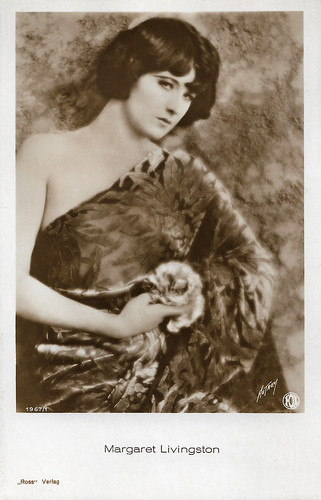
German postcard by Ross Verlag, no. 1967/1, 1927-1928. Photo: Max Munn Autrey / Fox.
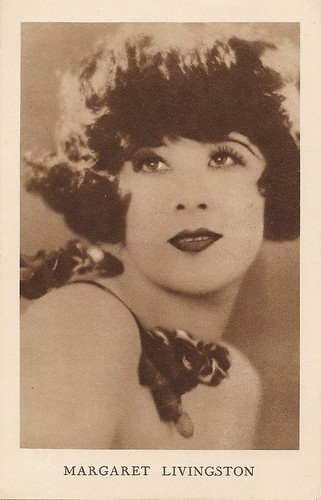
Belgian postcard, made for the Antwerp film journal Cinema.

Spanish postcard by Editorial Grafica, Barcelona, in the series 'Estrellas del cine', no. 155. Photo: Columbia.
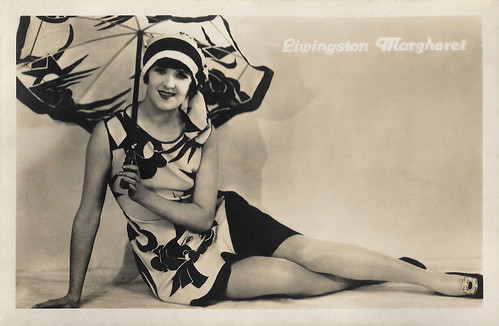
Italian postcard by Fotocelere.
Unlike many other silent film stars, Margaret Livingston effortlessly made the transition to the sound film, including Smart Money (Alfred E. Green, 1931) starring Edward G. Robinson and James Cagney.
In The Canary Murder Case (Malcolm St. Clair, Frank Tuttle, 1929), she lent her voice to Louise Brooks, who had refused to participate in the dubbing of the original silent film. For the sound version, some scenes had to be re-shot, where Livingston was also used as a double for Brooks. However, she was only seen from the back or from the side.
Margaret Livingston was then in about 20 sound film productions before she finally retired to private life. In 1934 she made her last feature film, called Social Register (Marshall Neilan, Harold Godsoe, 1934), staring Colleen Moore.
Since Livingston rarely worked with well-known directors, her films are now largely forgotten. Memorable, however, was the ice-cold vamp which Margaret Livingston embodied in 1927 in Friedrich Wilhelm Murnau's Sunrise/Sunrise - A Song of To Humans, produced by Fox.
By the mid-1920s she was earning 1000 dollars a week at Fox, while the star Janet Gaynor earned 1500, but that was after her breakthrough in Sunrise - for which she only got 100 dollars a week.
Margaret Livingston died in 1984 in Warrington, Pennsylvania, USA. Since 1931 she was married to jazz musician Paul Whiteman (1890-1967). The marriage remained childless. Her sister Ivy (1894-1986) also worked as an actress.

Italian postcard by Casa Editrice Ballerini & Fratini, Firenze (B.F.F.), no. 710. Photo: Albert Witzel / Fox Film Corp., Roma.

Italian postcard by G.B. Falci, Milano, no. 621. Photo: Fox. Margaret Livingston in the lost film The Wheel (Victor Schertzinger, 1925), released in Italy as Madame Roulette.
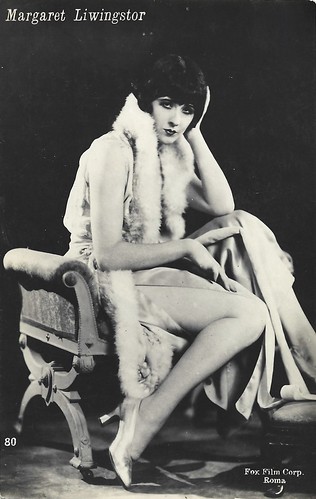
Italian postcard by Ed. Ballerini & Fratini, Firenze (B.F.F.), no. 80. Photo: Fox Film Corp., Roma.

Italian postcard by Ed. Ballerini & Fratini, Firenze (B.F.F.), no. 176. Photo: Fox Film Corp., Roma. Margaret Livingston and Robert Cain in When the Door Opened (Reginald Barker, 1925), released in Italy as L'ospite senza nome (The Unknown Guest). The plot deals with a husband (Walter McGrail) who unexpectedly returns home and sees his wife (Livingston) in the arms of an unknown man (Cain). He shoots him...

Italian postcard by G.B. Falci, Milano, no. 720. Photo: Fox Films.
Sources: Wikipedia (English and German), and IMDb.
This post was last updated on 26 March 2026.

Italian postcard by G. B. Falci Editore, Milano, no. 284. Photo: Fox Film. Publicity still for Sunrise (F.W. Murnau, 1927).

French postcard in the Les Vedettes de Cinéma series by A.N., Paris, no. 204. Photo: Albert Witzel / Fox Film.

Austrian postcard by Iris Verlag, no. 381-1. Photo: Albert Witzel, Hollywood / Fox Film.

Austrian postcard by Iris Verlag, no. 381-2. Photo: Albert Witzel, Hollywood / Fox Film.
Dark, slit-like eyes
Margaret Livingston was born in Salt Lake City as the daughter of Scottish immigrant John Livingston and his wife Eda from Stockholm.
Livingston came to the cinema as a teenager. Unlike other actresses of her time, she had not previously gained any stage experience. In The Chain Invisible (Frank Powell, 1916), the actress, who initially also appeared under the name of Marguerite Livingston, first appeared on the screen.
She became a sought-after actress in the 1920s and appeared in almost 50 films until the end of the silent film era. Only rarely, the petite, just 1.60 m tall actress with the chestnut hair and the dark, slit-like eyes, had leading roles.
Often she played the female antagonist to the female lead. Several times she played seductresses of European descent, e.g. the French women in His Private Life (Frank Tuttle, 1928) with Adolphe Menjou, and Innocents of Paris (Richard Wallace, 1929) with Maurice Chevalier.
In the early 1920s, Livingston often played at Paramount, in the mid-1920s at Fox and at the end of the decade at Paramount, mixed with a wide string of other companies, such as First National, Pathé Exchange, Tiffany, FBO, Universal, and MGM.

German postcard by Ross Verlag, no. 1967/1, 1927-1928. Photo: Max Munn Autrey / Fox.

Belgian postcard, made for the Antwerp film journal Cinema.

Spanish postcard by Editorial Grafica, Barcelona, in the series 'Estrellas del cine', no. 155. Photo: Columbia.

Italian postcard by Fotocelere.
Ice-cold vamp
Unlike many other silent film stars, Margaret Livingston effortlessly made the transition to the sound film, including Smart Money (Alfred E. Green, 1931) starring Edward G. Robinson and James Cagney.
In The Canary Murder Case (Malcolm St. Clair, Frank Tuttle, 1929), she lent her voice to Louise Brooks, who had refused to participate in the dubbing of the original silent film. For the sound version, some scenes had to be re-shot, where Livingston was also used as a double for Brooks. However, she was only seen from the back or from the side.
Margaret Livingston was then in about 20 sound film productions before she finally retired to private life. In 1934 she made her last feature film, called Social Register (Marshall Neilan, Harold Godsoe, 1934), staring Colleen Moore.
Since Livingston rarely worked with well-known directors, her films are now largely forgotten. Memorable, however, was the ice-cold vamp which Margaret Livingston embodied in 1927 in Friedrich Wilhelm Murnau's Sunrise/Sunrise - A Song of To Humans, produced by Fox.
By the mid-1920s she was earning 1000 dollars a week at Fox, while the star Janet Gaynor earned 1500, but that was after her breakthrough in Sunrise - for which she only got 100 dollars a week.
Margaret Livingston died in 1984 in Warrington, Pennsylvania, USA. Since 1931 she was married to jazz musician Paul Whiteman (1890-1967). The marriage remained childless. Her sister Ivy (1894-1986) also worked as an actress.

Italian postcard by Casa Editrice Ballerini & Fratini, Firenze (B.F.F.), no. 710. Photo: Albert Witzel / Fox Film Corp., Roma.

Italian postcard by G.B. Falci, Milano, no. 621. Photo: Fox. Margaret Livingston in the lost film The Wheel (Victor Schertzinger, 1925), released in Italy as Madame Roulette.

Italian postcard by Ed. Ballerini & Fratini, Firenze (B.F.F.), no. 80. Photo: Fox Film Corp., Roma.

Italian postcard by Ed. Ballerini & Fratini, Firenze (B.F.F.), no. 176. Photo: Fox Film Corp., Roma. Margaret Livingston and Robert Cain in When the Door Opened (Reginald Barker, 1925), released in Italy as L'ospite senza nome (The Unknown Guest). The plot deals with a husband (Walter McGrail) who unexpectedly returns home and sees his wife (Livingston) in the arms of an unknown man (Cain). He shoots him...

Italian postcard by G.B. Falci, Milano, no. 720. Photo: Fox Films.
Sources: Wikipedia (English and German), and IMDb.
This post was last updated on 26 March 2026.
No comments:
Post a Comment